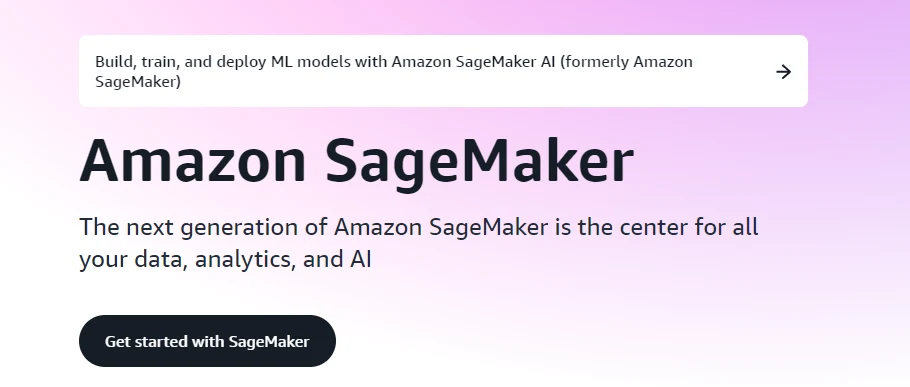Generative AI is reshaping industries by creating new possibilities in content generation, automation, and innovation. AWS (Amazon Web Services) provides powerful tools and infrastructure to build, deploy, and scale generative AI models. Whether you’re generating text, images, or code, AWS offers seamless solutions to help businesses integrate generative AI into their workflows.
In this article, we’ll explore how AWS enables generative AI development and provide practical ways businesses can apply these technologies to drive growth and efficiency.
AWS Services Powering Generative AI
1. Amazon Bedrock
Amazon Bedrock is AWS’s flagship generative AI service that provides access to foundational models (FMs) from leading providers like AI21 Labs, Anthropic, Stability AI, Meta (Llama 2), and AWS’s own Titan models.

Key Benefits:
- Infrastructure-Free: Deploy generative AI without managing the underlying infrastructure.
- Model Variety: Access and experiment with various models, including text generation, image synthesis, and multimodal models.
- Customization: Fine-tune foundational models with your data, ensuring they align with your specific business needs.
Use Case: A retail company can use Bedrock to build personalized recommendation systems by generating tailored product descriptions based on customer preferences.
2. Amazon SageMaker
SageMaker allows businesses to build, train, and deploy custom generative AI models at scale. From large language models (LLMs) to image generators, SageMaker provides the tools to accelerate AI development.

Key Features:
- Distributed Training: Train large models efficiently across multiple GPUs.
- Pre-Trained Models: Utilize SageMaker JumpStart for ready-to-use generative models.
- MLOps Integration: Automate and manage model lifecycles.
Use Case: A healthcare provider can fine-tune generative AI models on SageMaker to synthesize patient data for research without compromising privacy.
3. AWS Inferentia and Trainium
AWS Inferentia and Trainium are custom AI chips designed to reduce the cost and improve the performance of generative AI workloads.

Inferentia is optimized for inference tasks, while Trainium is designed for cost-effective, high-performance model training.
Use Case: A financial institution can deploy generative AI-driven fraud detection systems at scale while reducing infrastructure costs using Inferentia.
4. Hugging Face on AWS
AWS partners with Hugging Face to bring their popular generative AI models directly into SageMaker environments. This enables developers to deploy Hugging Face models with minimal effort.

Use Case: A media company can leverage Hugging Face models to generate automated summaries for articles and videos, improving content turnaround times.
5. Amazon CodeWhisperer
Amazon CodeWhisperer is an AI-powered code generation tool that suggests code snippets in real time, enhancing developer productivity.
Use Case: Software companies can accelerate development by integrating CodeWhisperer into their IDEs, reducing manual coding and debugging efforts.
Practical Applications of Generative AI for Businesses
Generative AI holds transformative potential across industries by unlocking efficiencies, creating new products, and enhancing customer experiences. Beyond simply automating tasks, generative models offer a new way to innovate by producing content, personalizing customer interactions, and driving intelligent automation. By leveraging AWS services, businesses can harness the power of generative AI to address unique challenges and expand market opportunities. Below are some of the most impactful applications businesses can explore today.
1. Content Creation and Personalization
Generative AI can automate content creation at scale, from product descriptions to personalized emails. AWS Bedrock and SageMaker allow businesses to generate content that resonates with individual customers, enhancing engagement and conversion rates.
Example: An e-commerce platform can automatically generate product descriptions tailored to specific demographics.
2. Customer Service Automation
Deploy AI-driven chatbots and virtual assistants that handle customer inquiries 24/7. Generative models like Anthropic’s Claude can be integrated via Bedrock to create highly responsive and human-like interactions.
Example: A telecom company can build an AI-powered support chatbot to handle billing inquiries, reducing call center workloads.
3. Product Design and Prototyping
Generative AI can produce design mockups, prototypes, and visual assets, significantly accelerating product development cycles.
Example: A fashion retailer can generate new clothing designs based on emerging trends, cutting down time-to-market.
4. Data Augmentation and Analysis
Generative AI can synthesize data to augment existing datasets, improving model accuracy for training other AI systems. This is useful in industries like healthcare, where data availability may be limited.
Example: A pharmaceutical company can generate synthetic medical records to train diagnostic models.
5. Software Development and Automation
Generative AI can assist in software development by writing boilerplate code, automating documentation, and generating tests.
Example: A SaaS provider can use Amazon CodeWhisperer to speed up new feature development.
Implementing Generative AI on AWS: A Step-by-Step Guide
- Choose the Right Model: Use Amazon Bedrock for foundational models or SageMaker for custom development.
- Fine-Tune with Data: Customize the model with proprietary data to align it with your business goals.
- Deploy at Scale: Use Inferentia for efficient inference or Trainium for cost-effective training.
- Integrate with Applications: Connect generative models to existing applications through APIs or Lambda functions.
- Monitor and Optimize: Continuously refine the models by collecting feedback and retraining with new data.
Conclusion
Generative AI is transforming how businesses operate, innovate, and engage customers. By leveraging AWS’s robust suite of tools, businesses can build scalable, cost-effective generative AI solutions tailored to their specific needs. From automating content creation to enhancing customer experiences, the possibilities are endless. Now is the time to explore generative AI on AWS and unlock new growth opportunities for your business.